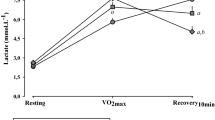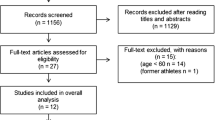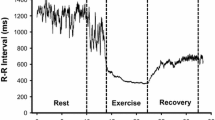Abstract
Purpose
Increased risk of arrhythmic events occurs at certain times during the circadian cycle with the highest risk being in the second and fourth quarter of the day. Exercise improves treatment outcome in individuals with cardiovascular disease. How different exercise protocols affect the circadian rhythm and the associated decrease in adverse cardiovascular risk over the circadian cycle has not been shown.
Methods
Fifty sedentary male participants were randomized into an 8-week high volume and moderate volume training and a control group. Heart rate was recorded using Polar Electronics and investigated with Cosinor analysis and by Poincaré plot derived features of SD1, SD2 and the complex correlation measure (CCM) at 1-h intervals over the 24-h period.
Results
Moderate exercise significantly increased vagal modulation and the temporal dynamics of the heart rate in the second quarter of the circadian cycle (p = 0.004 and p = 0.007 respectively). High volume exercise had a similar effect on vagal output (p = 0.003) and temporal dynamics (p = 0.003). Cosinor analysis confirms that the circadian heart rate displays a shift in the acrophage following moderate and high volume exercise from before waking (1st quarter) to after waking (2nd quarter of day).
Conclusions
Our results suggest that exercise shifts vagal influence and increases temporal dynamics of the heart rate to the 2nd quarter of the day and suggest that this may be the underlying physiological change leading to a decrease in adverse arrhythmic events during this otherwise high-risk period.





Similar content being viewed by others
Abbreviations
- AC:
-
Acrophase
- AMI:
-
Acute myocardial infarct
- Amp:
-
Amplitude
- ANS:
-
Autonomic nervous system
- CCM:
-
Complex correlation measure
- HRmax :
-
Maximum heart rate
- HRV:
-
Heart rate variability
- MESOR:
-
Midline-estimating statistic of rhythm
- RQmax :
-
Maximum respiratory quotient
- R-R:
-
Peaks between the QRS waves (RR interval)
- SCD:
-
Sudden cardiac death
- SD1:
-
Width of the Poincaré plot
- SD2:
-
Length of the Poincaré plot
- VO2peak :
-
Highest value of O2 consumption
References
Achten J, Jeukendrup AE (2003) Heart rate monitoring: applications and limitations. Sports Med 33:517–538
Amano M, Kanda T, Ue H, Moritani T (2001) Exercise training and autonomic nervous system activity in obese individuals. Med Sci Sports Exerc 33:1287–1291
Boudreau P, Yeh WH, Dumont GA, Boivin DB (2012) A circadian rhythm in heart rate variability contributes to the increased cardiac sympathovagal response to awakening in the morning. Chronobiol Int 29:757–768
Brennan M, Palaniswami M, Kamen P (2001) Do existing methods of Poincare plot geometry reflect nonlinear features of heart rate variability? IEEE Trans Biomed Eng 48:1342–1347
Brennan M, Palaniswami M, Kamen P (2002) Poincare plot interpretation using a physiological model of HRV based on a network of oscillators 2. Am J Physiol Heart Circ Physio 283:H1873–H1886
Buchheit M, Gindre C (2006) Cardiac parasympathetic regulation: respective associations with cardiorespiratory fitness and training load. Am J Physiol Heart Circ Physiol 291:H451–H458
Buchheit M, Simon C, Piquard F, Ehrhart J, Brandenberger G (2004) Effects of increased training load on vagal-related indexes of heart rate variability: a novel sleep approach. Am J Physiol Heart Circ Physiol 287:H2813–H2818
Carter JB, Banister EW, Blaber AP (2003) Effect of endurance exercise on autonomic control of heart rate. Sports Med 33:33–46
Cottin F, Medigue C, Lepretre PM, Papelier Y, Koralsztein JP, Billat V (2004) Heart rate variability during exercise performed below and above ventilatory threshold. Med Sci Sports Exerc 36:594–600
Fernández JR, Hermida RC, Mojón A (2009) Chronobiological analysis techniques. Application to blood pressure. Phil Trans R Soc A 367:431–445
Furlan R, Guzzetti S, Crivellaro W, Dassii S, Tinelli M, Baseli G, Ceruti S, Lomardi F, Pagani M, Malliani A (1990) Continuous 24-h assessment of the neural regulation of systemic arterial pressure and and RR variabilities in ambulant subjects. Circulation 81:537–547
Goldberger JJ, Le FK, Lahiri M, Kannankeril PJ, Ng J, Kadish AH (2006) Assessment of parasympathetic reactivation after exercise. Am J Physiol Heart Circ Physiol 290:H2446–H2452
Guo Y-F, Stein PK (2003) Circadian rhythm in the cardiovascular system: chronocardiology. Am Heart J 145:779–786
Halberg F (1969) Chronobiology. Ann Rev Physiol 1:675–725
Halberg F, Johnson EA, Nelson W, Runge W, Sothern R (1973) Autorhythmometry procedures for physiologic self-measurements and their analysis. Physiol Teach 1:1–11
Hautala AJ, Mäkikallio TH, Kiviniemi A, Laukkanen RT, Nissilä S, Huikuri HV, Tulppo MP (2003) Cardiovascular autonomic function correlates with the response to aerobic training in healthy sedentary subjects. Am J Physiol Heart Circ Physiol 285:H1747–H1752
Hautala AJ, Mäkikallio TH, Kiviniemi A, Laukkanen RT, Nissilä S, Huikuri HV, Tulppo MP (2004) Heart rate dynamics after controlled training followed by home-based exercise program. Eur J Appl Physiol 92:289–297
Hu K, Ivanov PC, Hilton MF, Chen Z, Ayers RT, Stanley HE, Shea SA (2004) Endogenous circadian rhythm in an index of cardiac vulnerability independent of changes in behavior. Proc Nat Acad Sci USA 101:18223–18227
Huikuri HV, Kessler KM, Terracall E, Castellanos A, Linnaluoto MK, Myerburg RJ (1990) Reproducibility and circadian rhythm of heart rate variability in healthy subjects. Am J Cardiol 65:391–393
Huikuri HV, Linnaluoto MK, Seppanen T, Airaksinen KE, Kessler KM, Takkunen JT, Myerburg RJ (1992) Circadian rhythm of heart rate variability in survivors of cardiac arrest. Am J Cardiol 70:610–615
Jeyaraj D, Haldar SM, Wan X, McCauley MD, Ripperger J, Hu K, Lu Y, Eapen BL, Sharma N, Ficker E, Cutler MJ, Gulick J, Sanbe A, Robbins J, Demolombe S, Kondratov RV, Shea SA, Albrecht U, Wehrens XHT, Rosenbaum DS, Jain MK (2012) Circadian rhythms govern cardiac repolarization and arrhythmogenesis. Nature 483:96–101
Kamen PW, Krum H, Tonkin AM (1996) Poincare plot of heart rate variability allows quantitative display of parasympathetic nervous activity in humans. Clin Sci 91:201–208
Karasik R, Sapir N, Adshkenazy Y, Ivanov PC, Dvir I, Lavie P, Havlin S (2002) Corrrelation differences in heartbeat fluctuations during rest and exercise. Phys Rev E 66:062902
Karmakar CK, Khandoker A, Gubbi J, Palaniswami M (2009) Complex correlation measure: a novel desciptor for Poincaré plot. Biomed Eng Online 8: http://www.biomedical-engineering-online.com/content/8/1/17
Karmakar C, Khandoker A, Voss A, Palaniswami M (2011) Sensitivity of temporal heart rate variability in Poincare plot to changes in parasympathetic nervous system activity. Biomed Eng Online 10:17
Khandoker AH, Jelinek HF, Moritani T, Palaniswami M (2010) Association of cardiac autonomic neuropathy with alteration of sympatho-vagal balance through heart rate variability analysis. Med Eng Phys 32:161–167
Kishida H, Suzuki T, Saito T, Kiuchi K, Yasutake H, Tanaka K, Hata N, Fukuma N (1989) Clinical significance and management of silent myocardial ischemia in patients with angina pectoris and myocardial infarction. Jpn Circ J 53:1444–1451
Lauer MS, Okin PM, Larson MG, Evans JC, Levy D (1996) Impaired heart rate response to graded exercise: Prognostic implications of chronotropic incompetence in the Framingham Heart Study. Circulation 93:1520–1526
Lecarpentier Y, Claes V, Hebert JL (2010) PPARs, cardiovascular metabolism, and function: near- or far-from-equilibrium pathways. PPAR Res. doi:10.1155/2010/783273
Mäkikallio TH, Barthel P, Schneider R, Bauer A, Tapanainen JM, Tulppo MP, Perkiomaki JS, Schmidt G, Huikuri HV (2006) Frequency of sudden cardiac death among acute myocardial infarction survivors with optimized medical and revascularization therapy. Am J Cardiol 97:480–484
Malfatto G, Facchini M, Bragato R, Branzi G, Sala L, Leonetti G (1996) Short and long term effects of exercise training on the tonic autonomic modulation of heart rate variability after myocardial infarction. Eur Heart J 17:532
Maury E, Ramsey KM, Bass J (2010) Circadian rhythms and metabolic syndrome: From experimental genetics to human disease. Circ Res 106:447–462
Mitler MM, Hajdukovic RM, Shafor R, Hahn PM, Kripke DF (1987) When people die: Cause of death versus time of death. Am J Med 82:266–274
Nakagawa M, Iwao T, Ishida S, Yonemochi H, Fujino T, Saikawa T, Ito M (1998) Circadian rhythm of the signal averaged electrocardiogram and its relation to heart rate variability in healthy subjects. Heart 79:493–496
Otsuka K, Cornélissen G, Halberg F (1997) Circadian rhythmic fractal scaling of heart rate variability in health and coronary artery disease. Clin Cardiol 20:631–638
Piepoli MF, Capucci A (2007) Autonomic nervous system in the genesis of arrhythmias in chronic heart failure: implication for risk stratification. Min Cardioangiol 55:325–333
Qtsuka K, Cornélissen G, Halberg F (1997) Circadian rhythmic fractal scaling of heart rate variability in health and coronary artery disease. Clin Cardiol 20:631–638
Ranpuria R, Hall M, Chan CT, Unruh M (2008) Heart rate variability (HRV) in kidney failure: measurement and consequences of reduced HRV. Nephrol Dial Transplant 23:444–449
Rennie KL, Hemingway H, Kumari M, Brunner E, Malik M, Marmot M (2003) Effects of moderate and vigorous physical activity on heart rate variability in a British study of civil servants. Am J Epidemiol 158:135–143
Scheer FAJL, Hu K, Evoniuk H, Kelly EE, Malhotra A, Hilton MF, Shea SA (2010) Impact of the human circadian system, exercise, and their interaction on cardiovascular function. Proc Nat Acad Sci USA. doi:10.1073/pnas.1006749107
Shanmugam V, Wafi A, Al-Taweel N, Büsselberg D (2013) Disruption of circadian rhythm increases the risk of cancer, metabolic syndrome and cardiovascular disease. J Local Global Health Sci. doi:10.5339/jlghs.2013.5333
Shaw E, Tofler GH (2009) Circadian rhythm and cardiovascular disease. Current Atheroscler Rep 11:289–295
Shea SA, Hilton MF, Hu K, Scheer FAJL (2011) Existence of an endogenous circadian blood pressure rhythm in humans that peaks in the evening Circ Res supplementary data 108(8):980–984. doi:10.1161/CIRCRESAHA.110.233668
Singh RB, Kartik C, Otsuka K, Pella D, Pella J (2002) Brain-heart connection and the risk of heart attack. Biomed Pharmacother 56:257s–265s
Singh RB, Cornélissen G, Weydahl A, Schwartzkopff O, Katinas G, Otsuka K, Watanabe Y, Yano S, Mori H, Ichimaru Y, Mitsutake G, Pella D, Fanghong L, Zhao Z, Rao RS, Gvozdjakova A, Halberg F (2003) Circadian heart rate and blood pressure variability considered for research and patient care. Int J Cardiol 87:9–28
Soares-Miranda L, Sandercock G, Valente H, Vale S, Santos R, Mota J (2009) Vigorous physical activity and vagal modulation in young adults. Eur J Cardiovasc Prevent Rehab 16:705–711
Stanley J, Peake JM, Buchheit M (2013) Cardiac parasympathetic reactivation following exercise: implications for training prescription. Sports Med 43:1259–1277
Su Y, Liu XM, Sun YM, Jin HB, Fu R, Wang YY, Wu Y, Luan Y (2008) The relationship between endothelial dysfunction and oxidative stress in diabetes and prediabetes. Int J Clin Pract 62:877–882
Thayer JF, Yamamoto SS, Brosschot JF (2010) The relationship of autonomic imbalance, heart rate variability and cardiovascular disease risk factors. Int J Cardiol 141:122–131
Tsuji H, Larson MG, Venditti FJ, Manders ES, Evans JC, Feldman CL, Levy D (1996) Impact of reduced heart rate variability on risk for cardiac Events: The Framingham Heart Study. Circulation 94:2850–2855
Tulppo MP, Mäkikallio TH, Takala TES, Seppänen T (1996) Quantitative beat-to-beat analysis of heart rate dynamics during exercise. Am J Physiol Heart Circ Physiol 271:H244–H252
Tulppo MP, Hautala AJ, Mäkikallio TH, Laukkanen RT, Nissilä S, Hughson RL, Huikuri HV (2003) Effects of aerobic training on heart rate dynamics in sedentary subjects. J Appl Physiol 95:364–372
Van Leeuwen P, Bettennann H, An der Heiden U, Kummell HC (1995) Circadian aspects of apparent correlation dimension in human heart rate dynamics. Am J Physiol Heart Circ Physiol 269:H130–H134
Viskin S, Golovner M, Malov N, Fish R, Alroy I, Vila Y, Laniado S, Kaplinsky E, Roth A (1999) Circadian variation of symptomatic paroxysmal atrial fibrillation. Data from almost 10000 episodes. Eur Heart J 20:1429–1434
Weydahl A, Cornelissen G, Halberg F, Siegelova J, Kumagai Y, Otsuka K (1998) Chronobiologic optimization of exercise physiology and practice guided by heart rate variability. Scripta Medica (Brno) 71:215–230
Willich SN, Levy D, Rocco MB, Tofler GH, Stone PH, Muller JE (1987) Circadian variation in the incidence of sudden cardiac death in the Framingham heart study population. Am J Cardiol 60:801–806
Willich SN, Goldberg RJ, Maclure M, Perriello L, Muller JE (1992) Increased onset of sudden cardiac death in the first three hours after awakening. Am J Cardiol 70:65–68
Zhou L, Zhang P, Cheng Z, Hao W, Wang R, Fang Q, Cao JM (2011) Altered circadian rhythm of cardiac beta3-adrenoceptor activity following myocardial infarction in the rat. Basic Res Cardiol 106:37–50
Conflict of interest
The authors declare no conflict of interests.
Author information
Authors and Affiliations
Corresponding author
Additional information
Communicated by Toshio Moritani.
Rights and permissions
About this article
Cite this article
Jelinek, H.F., Karmakar, C., Kiviniemi, A.M. et al. Temporal dynamics of the circadian heart rate following low and high volume exercise training in sedentary male subjects. Eur J Appl Physiol 115, 2069–2080 (2015). https://doi.org/10.1007/s00421-015-3185-x
Received:
Accepted:
Published:
Issue Date:
DOI: https://doi.org/10.1007/s00421-015-3185-x




